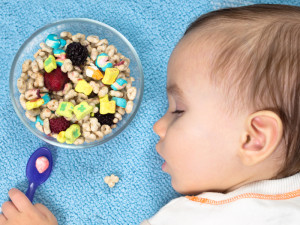It’s Less Work than You Think (Healthy Snacks)
/When I’m introducing my concept of 5-6 equal opportunities to eat to Moms and Dads many think that it sounds impossible – it’s too much work. But I promise you it’s not. In fact, it’s likely the same amount of work that you’re currently doing. But it’s work that’s moving you in the right direction of getting your picky eater to try new foods (instead of inadvertently fuelling pickier eating).
But I think I’m getting ahead of myself here. First let me explain what I mean by 5-6 equal opportunities to eat.
Toddlers and preschoolers have little tummies, short attention spans, and big nutrition needs. That’s why they need more than just 3 meals a day. I’ve found that most kids so best with three meals plus two or three snacks per day.
When I say the word “meal”, you likely imagine something with healthy foods from multiple food groups, perhaps eaten while sitting at a table. In contrast, when I say the word “snack” you likely think of something small to eat, perhaps less healthy foods, grabbed and eaten on the run.
Most toddlers and preschoolers don’t have appetites that are bigger at “meal” times and smaller at “snack” times. Instead of differentiating between “meals” and “snacks”, I recommend treating these as all as “opportunities to eat”.
So, instead of giving your child 3 meals plus 2 – 3 snacks per day, I recommend re-framing the concept to offering 5 – 6 opportunities to eat each day.
But the phrase that I started with in this post had the word “equal” in it: “5 – 6 equal opportunities to eat” .
Here’s where the “equal” comes into play.
To best meet kids’ nutrition needs in the face of their short attention spans, I recommend taking each of the 5 – 6 opportunities to eat to provide kids with healthy foods. This way if they eat a lot at afternoon snack and only two bites at dinner, it’s less of a worry than if you gave your child junky foods at afternoon snack and were relying on dinner for those vegetables, fruit, and whole grains.
Consider each opportunity to eat an equal opportunity to provide healthy foods from 2 – 4 food groups. Yes, this may mean that you’re putting more thought and effort onto your child’s snacks.
However, I can’t tell you how many families I’ve worked with who are providing quick snack handouts all day long. These parents are feeding their kids almost every hour of the day. That’s a lot of work!!
Instead of putting all your time and effort into providing constant snacks, I recommend offering 5 – 6 equal opportunities to eat each day, each of which has 2 – 4 food groups.
It’s less work than you think. And, you will be more successful in helping your child get the nutrition they need and have less picky eating behaviour.
Have you been using the 5 – 6 equal opportunities to eat strategy? Have you found it to be more work? I’d love you to share your experience in the comment section below!
Get more successful picky eater tips delivered directly to your inbox when you sign up for my e-newsletter.















 Recently a parent asked me this question: “How much cow’s milk to offer toddlers. Do you allow them to regulate/drink as much as they want or just fill the cup up once and then when it's empty that's it? Being only 17 months, he can fill up pretty quick on milk during the meal, but I also don't want to be taking it away. I would prefer to just allow him to self regulate, but not sure what to do once the sippy cup is empty.”
Recently a parent asked me this question: “How much cow’s milk to offer toddlers. Do you allow them to regulate/drink as much as they want or just fill the cup up once and then when it's empty that's it? Being only 17 months, he can fill up pretty quick on milk during the meal, but I also don't want to be taking it away. I would prefer to just allow him to self regulate, but not sure what to do once the sippy cup is empty.”
 {
{
 It happened again yesterday. I was leading a workshop and a parent asked me: “Is it wrong to give my child smoothies with veggies in them? Is this considered hiding veggies?” Rarely a workshop goes by without a parent asking me about smoothies for their picky eater kids. They’re such a popular trend these days. While I touched on this in last week’s blog post; it’s such a common question that I get about healthy snacks for kids that I thought that it was worthwhile to expand on it today. And, share some ideas for smoothie ingredients.
It happened again yesterday. I was leading a workshop and a parent asked me: “Is it wrong to give my child smoothies with veggies in them? Is this considered hiding veggies?” Rarely a workshop goes by without a parent asking me about smoothies for their picky eater kids. They’re such a popular trend these days. While I touched on this in last week’s blog post; it’s such a common question that I get about healthy snacks for kids that I thought that it was worthwhile to expand on it today. And, share some ideas for smoothie ingredients. I shared this post previously with the
I shared this post previously with the  Thank you to the parent at a recent workshop in Victoria BC who asked this baby feeding question: "What does it mean when I see whole pieces of food in my baby’s poop?" It’s amazing the topics of conversation that you have once becoming a parent, eh?!
This Mom had recently started feeding her baby finger foods and was seeing pieces of food in her baby’s diaper. It’s often not talked about, but when you start to feed your baby solid foods, you will see a change in their bowel movements.
Thank you to the parent at a recent workshop in Victoria BC who asked this baby feeding question: "What does it mean when I see whole pieces of food in my baby’s poop?" It’s amazing the topics of conversation that you have once becoming a parent, eh?!
This Mom had recently started feeding her baby finger foods and was seeing pieces of food in her baby’s diaper. It’s often not talked about, but when you start to feed your baby solid foods, you will see a change in their bowel movements.